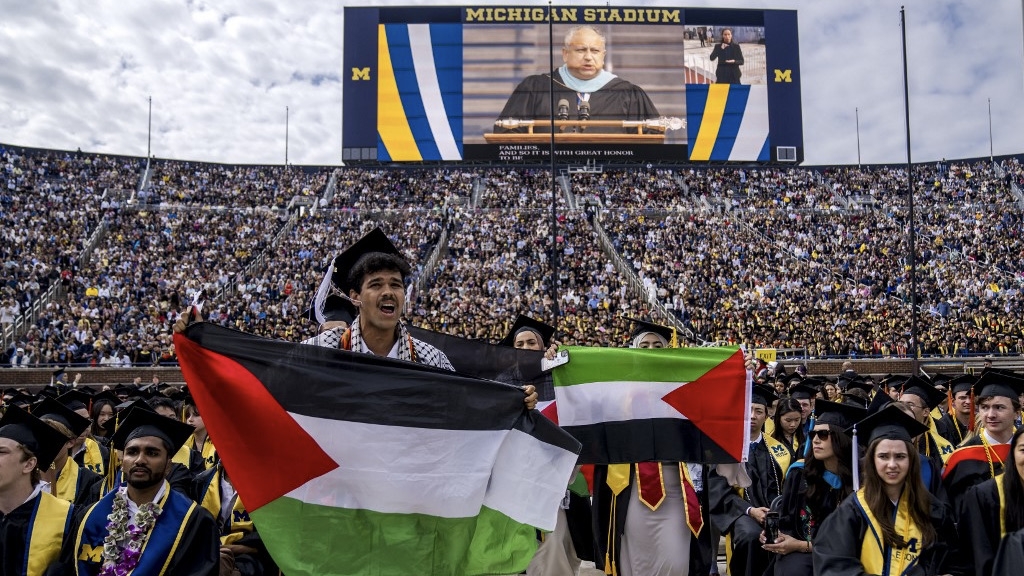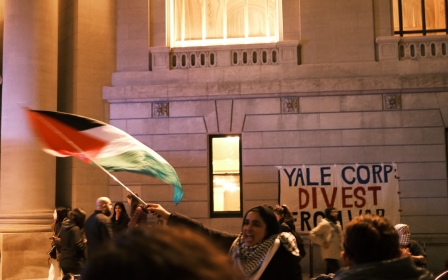The crucial difference between the Gaza and Vietnam student protests

A mass movement of students in the United States against war becomes the spark for a global series of student protests. The protests come out of a wider movement and feed back into it, radicalising it as they do so.
The business-centred administrations of the universities are challenged by the students' demands. The authorities' attempts to deal with the protests lead to further radicalisation.
These are observations about the student movement now still unfolding in solidarity with Palestine, but they could as well be a historical account of the student protests over the Vietnam War.
The similarities are striking.
In the 1960s, the student anti-war movement was largest in the US, but became global. Today the same pattern is emerging.
In the US, there have been 140 campuses hit by student walkouts or sit-ins across 45 states. Student action has now spread to over 30 countries worldwide. These are less powerful than the US movement, but Australia, Canada, the UK and the Netherlands are among the most effective.
In 1968, the movement was energised by the Vietnamese Tet Offensive, just as today it is motivated by opposition to the Israeli attack on Gaza. In both cases, military success favoured the colonial powers and their supporters, but in both cases, the political victory was won by the resistance.
Tet turned global opinion against the US war in Vietnam just as the attack on Gaza has led to the political isolation of the Israeli state on the global stage.
'Replaceable and irrelevant'
In the US and the UK, the student protest movement is strongest in the elite universities with, in Britain, Warwick, UCL, Soas, Oxford, Cambridge, Bristol and Queen Mary University London among the first to take action.
Both in the 1960s and now, there is a wider movement to which the student movement owes its inspiration.
Follow Middle East Eye's live coverage of the Israel-Palestine war
The movements of the 1960s opposed the corporatisation and standardisation of education, the factory production line model of teaching.
Mario Savio, leader of the Berkeley students in the 1960s, said they were reacting against the "chrome-plated consumers' paradise" which wanted "us to grow up to be well-behaved children".
"But," he said, "an important minority… have shown they would rather die than be standardised, replaceable and irrelevant."
Today's students, after more than a generation of cuts and commercialisation in the higher education sector, are hardly reacting against a consumer paradise, but they have seen, even more completely than the 1960s generation, what a fully marketised, corporate-model university system looks like.
They know only too well what it feels like to be treated as "standardised, replaceable and irrelevant".
Important differences
But there are also important differences. In the US in the 1960s, the movement was in part driven forward by opposition to the draft. Today's movement has no such immediate spur.
In the UK, the anti-Vietnam War movement was dominated by students, who made up well over half the major anti-war marches. That is not the case today. The mass movement had been mobilising on an unprecedented scale for eight months before the students moved into action in the UK.
In the UK, the largest of the anti-Vietnam War demonstrations in 1968 numbered 100,000 people, smaller than the smallest of the repeated Palestine marches, which was 150,000, and dwarfed by the largest, which numbered 800,000
Moreover, in 1967 and 1968, there were only two large-scale national marches in the UK. In the last eight months, there have been 14 national demonstrations for Palestine.
The student movement of 2024 in the UK is probably more widespread than in 1968 alone, but the form of action is not yet as radical as it was in 1968.
Then, students occupied college buildings, a direct disruption of the college's ability to function. The encampments do not achieve that goal.
In 1968, the revolutionary paper Black Dwarf, supported by the most prominent anti-Vietnam War campaigner, Tariq Ali, reported that Essex University had been "either in a state of partial or total disorder" from February to June. Student action would have to escalate considerably before such a claim could be made for any college today.
Widespread anger
There is also another dissimilarity, but on closer examination, it turns out to be a similarity.
In 1968 in the UK, Labour was in government and Harold Wilson was prime minister. When Wilson spoke at Sheffield town hall in January 1968, some 3,000 people surrounded the building chanting "Wilson out!", bombarding the police defending the prime minister with eggs and tomatoes.
In March of that year, a Labour minister was shouted down at the University of Manchester and a week later Defence Secretary Denis Healey's car was surrounded by students in Cambridge.
Today, of course, the Tories are in power. Yet so closely does Keir Starmer's Labour Party mirror Prime Minister Rishi Sunak's government on Palestine and much else that there is widespread anger against his party; an anger which almost assumes that he will be no different to those currently in power should he win, as is widely expected, the upcoming general election.
Whatever the exact balance of continuities and discontinuities between the student movements of the 1960s and today, they are certainly both on a historically significant scale
Whatever the exact balance of continuities and discontinuities between the student movements of the 1960s and today, they are certainly both on a historically significant scale. If the student movement is not as prominent or as radical yet as it was in the 1960s, it is far less isolated.
In the 1960s in the US, the Black Power movement was a significant component of a society-wide radicalisation. But there was no comparable constituency in the UK at that time. Today, the Muslim community contributes on a much more significant scale to the Palestine mobilisations.
That said, as the opinion polls show, support for Palestinians is society-wide. Two out of every three people in the UK want a ceasefire in Gaza, the very demand on the banners of the Palestine demonstrations.
The students are not a vanguard, because much wider sections of society already have the same attitude to the Palestine struggle as they do, and they have shown a remarkable capacity to mobilise consistently and repeatedly over months on a mass scale.
That breadth of action is new.
The views expressed in this article belong to the author and do not necessarily reflect the editorial policy of Middle East Eye.
Middle East Eye propose une couverture et une analyse indépendantes et incomparables du Moyen-Orient, de l’Afrique du Nord et d’autres régions du monde. Pour en savoir plus sur la reprise de ce contenu et les frais qui s’appliquent, veuillez remplir ce formulaire [en anglais]. Pour en savoir plus sur MEE, cliquez ici [en anglais].






